St Edmund's College, Cambridge
| St Edmund's College | ||||||||||||||||||
|---|---|---|---|---|---|---|---|---|---|---|---|---|---|---|---|---|---|---|
| University of Cambridge | ||||||||||||||||||
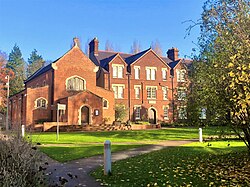 St Edmund's College Chapel | ||||||||||||||||||
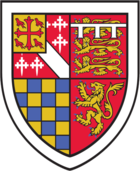 Arms of St Edmund's College Arms: Arms of Henry Fitzalan-Howard, 15th Duke of Norfolk (quarterly of four: Howard, Brotherton, Warenne, FitzAlan) with a canton of St Edmund of Abingdon (Or, a cross fleury gules between four Cornish choughs proper[1]) all within a bordure argent | ||||||||||||||||||
| Location | Mount Pleasant (map) | |||||||||||||||||
| Full name | The Master, Fellows and Scholars of St Edmund’s College in the University of Cambridge | |||||||||||||||||
| Latin name | Collegium Sancti Edmundi | |||||||||||||||||
| Abbreviation | ED[2] | |||||||||||||||||
| Motto | Per Revelationem et Rationem (Latin) | |||||||||||||||||
| Founders | ||||||||||||||||||
| Established | 1896 | |||||||||||||||||
| Named after | Edmund of Abingdon | |||||||||||||||||
| Previous names | St Edmund's House | |||||||||||||||||
| Age restriction | Aged 21 and older | |||||||||||||||||
| Sister college | Green Templeton College, Oxford | |||||||||||||||||
| Master | Catherine Arnold | |||||||||||||||||
| Undergraduates | 104 | |||||||||||||||||
| Postgraduates | 449 | |||||||||||||||||
| Endowment | £18.1m (2019)[3] | |||||||||||||||||
| Visitor | Cardinal Vincent Nichols, Archbishop of Westminster | |||||||||||||||||
| Website | www | |||||||||||||||||
| CR | www | |||||||||||||||||
| Map | ||||||||||||||||||
 Location in Central Cambridge | ||||||||||||||||||
St Edmund's College is a constituent college of the University of Cambridge in England. Founded in 1896, it is the second-oldest of the four Cambridge colleges oriented to mature students, which only accept students reading for either masters or doctorate degrees, or undergraduate degrees if they are a 'mature student', defined as aged 21 or older.
Named after St Edmund of Abingdon (1175–1240), who was the first known Oxford Master of Arts and the Archbishop of Canterbury from 1234 to 1240, the college has traditionally Roman Catholic roots. Its founders were Henry Fitzalan Howard, the 15th Duke of Norfolk, then the most prominent Roman Catholic in England, and Baron Anatole von Hügel, the first Catholic to take a Cambridge degree since the Glorious Revolution of 1688.[4] In recognition of this Catholic connection, the College Visitor is the Archbishop of Westminster (at present Cardinal Vincent Nichols).[5]
The college is located on Mount Pleasant, northwest of the centre of Cambridge, beside Lucy Cavendish College, Murray Edwards College and Fitzwilliam College. Its campus consists of a garden setting on the edge of what was Roman Cambridge, with housing for over 350 students.
Members of St Edmund's include cosmologist and Big Bang theorist Georges Lemaître, Lord St John of Fawsley, Archbishop Eamon Martin of Armagh, Bishop John Petit of Menevia, and Olympic Medalists Thorsten Streppelhoff, Marc Weber, Stuart Welch and Simon Amor. Historically, St Edmund's was also the residential college of the university's first Catholic students in two hundred years – most of whom were studying for the Priesthood – after the lifting of the papal prohibition on attendance at the Universities of Oxford and Cambridge in 1895 at the urging of a delegation to Pope Leo XIII led by Baron von Hügel.[6]
History[]
Founding[]
St Edmund's House was founded in 1896 by Henry Fitzalan Howard, the 15th Duke of Norfolk, and Baron Anatole von Hügel as an institution providing board and lodging for Roman Catholic students at the University of Cambridge. After Catholic Emancipation, in particular after the Universities Tests Act 1871, students who were Roman Catholics were finally admitted as members of the university. In its early days the college functioned predominantly as a lodging house, or hall of residence, for students who were matriculated at other colleges. Most of the students, at that time, were ordained Catholic priests who were reading various subjects offered by the university. The college was established in the buildings of Ayerst Hostel, which had been set up for non-collegiate students by the Reverend William Ayerst in 1884, and its founding master for Fr Edmund Nolan, then Vice-Rector of St Edmund's College Ware.[6] In 1896 Ayerst Hostel had to close due to lack of funds, and the property was transferred to the Catholic Church.[7]
Attempts to make St Edmund's House into a fully-fledged constituent college were made at various times after foundation, but were met by continuing hostility by the predominantly Protestant body of Cambridge MAs, graduates of the university who had the right to vote in the Senate House. Due to Cambridge's largely Anglican student body, large numbers of MAs scuppered any attempt to grant St Edmund's House full collegiate status as they viewed it as a "papist" institution.[8]
Despite the initial pushback, the college continued its development, and the chapel was officially consecrated in 1916 by Cardinal Francis Bourne, Archbishop of Westminster.[9] A new dining hall was constructed in 1939 and the membership of the college increased steadily as it became a recognized House of Residence of the university, just below official college status.
Development[]
In response to growing postgraduate student numbers in the early 1960s, the Regent House of the university established several colleges primarily for postgraduate students, and St Edmund's House became one of the graduate colleges in the university (the others being Wolfson College, Lucy Cavendish College, Hughes Hall, Clare Hall and Darwin College). This spurred further progress regarding St Edmund's status within the university, and in 1965, the college was permitted to matriculate its own students and new fellows were elected. In 1975 St Edmund's acquired the status of an "Approved Foundation", and after the transfer of the college assets from the Catholic Church to the Masters and Fellows of the college in 1986, the college changed its name from "St Edmund's House" to "St Edmund's College". It received university approval for full collegiate status in 1996, and was granted its Royal Charter in 1998.[10][11] The college now accepts students of all faiths and none; the Catholic character of the foundation is, however, still reflected in the chapel, which is unique among colleges of the universities of Cambridge and Oxford in following the Roman Catholic tradition.
Expansion[]
In 2000, a new residential building housing 50 students was opened, named after Richard Laws, one of the former masters. In 2006, two new residential buildings, including rooms for 70 students as well as apartments for couples, were opened; these were named after the former master of the college, Sir Brian Heap, and the former vice-master, Geoffrey Cook.
In 2016, major plans were announced for the development of two new courts and several buildings which will expand the college and provide modern, world class facilities for the scholars and students of St Edmunds College. While contemporary, the buildings external features and material will be in the traditional architectural vernacular that is found elsewhere in the college. Large brick buildings with close detail will form the perimeter of the two new courts and a new multi-million pound student centre will frame the west side of the college. The expansion plans were approved by Cambridge city councillors in June 2017.[12][circular reference]
Buildings and grounds[]
Norfolk Building[]
The Norfolk Building is the oldest building on site, dating back to 1896 as the former Ayerst Hostel; it provided accommodation for Fr Edmond Nolan, the first Master of St Edmund's, along with the first four students of the college.[13] Known for its clean Gothic revival style, the building underwent a three-phased extension scheme designed by the late Roderick Gradidge in 1989, and now houses 21st century amenities including the Middle Combination Room, Dining Hall, Kitchens and a Porter's office.[14]
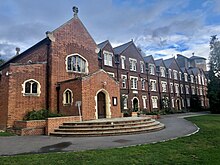
Okinaga Tower[]
Created in 1993 by the bequest of the Teikyo Foundation, the Okinaga Tower is the college's tallest structure. It houses the master's lodge, as well as an air-conditioned suite with views of the city centre. The tower was opened by the Right Honourable Betty Boothroyd, Speaker of the House of Commons.[14]
Chapel[]
St Edmund's College Chapel is a Grade II listed building designed by Fr. Benedict Williamson, CSSP, and blessed by Cardinal Francis Bourne, Archbishop of Westminster, in 1916.[13] Noted for its prayerful simplicity and Gothic Revival architecture, the chapel is a Catholic foundation, although it is open to other denominations of the Christian faith.[15] In 2003, a stained glass window depicting the ministry of St Boniface of Crediton (c. 675 - 754 AD), the apostle to Germany, was donated by Professor Stephen Frowen and blessed by Cardinal Cormac Murphy-O'Connor, Archbishop of Westminster.[15]
A bronze sculpture of the college patron, St Edmund of Abingdon, sits at the front of the chapel, his left hand holding a bible. The statue was made by Rodney Munday, an alumnus of St Edmund Hall, Oxford, and commissioned by the college in 2007.[15] The Chapel Schola and Choir frequently perform in concerts in collaboration with St Edmund Hall, Oxford and St Edmund's College, Ware in commemoration of their college patron.
Courts and other buildings[]
Old Court, built in the early 2000s, is located to the west of the Norfolk Building, and surrounded by New Edwardian buildings: Brian Heap Building, Richard Laws Building, Geoffrey Cook Building and the Library Building. It was constructed to accommodate growing student numbers at this time, and most of its constituent buildings are appropriately student dormitories.
New Court, constructed in 2019, consists entirely of the new student accommodation buildings, Mount Pleasant Halls.
The College Sporting Grounds is located west of the Richard Laws Building, and offers a full-sized soccer pitch for college sports and other outdoor activities.
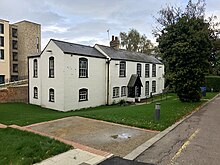
The College Orchard is south of the Sporting Grounds, and consists of expansive lawns with 5 apple trees, outdoor seating, and a barbecue pit for students.
White Cottage is a Tudor style Grade II listed building situated directly east of the Norfolk Building Extension that accommodates first-year students. It is the former home of the Von Hugel Institute, a Catholic Institute that undertakes academic work in the fields of Christianity and society and was founded in 1987 to preserve the Roman Catholic heritage of the college.[16]
Bene't House is an Edwardian style building located south-east of the Norfolk Old Wing. Named after St Benedict for Nursia (c.480 - 547 AD), the house has since 2018 contained the facilities and offices for the Von Hugel Institute, and hosted the Von Hugel and Lattey Lecture.[16]
Gallery[]
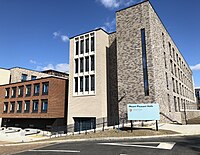
Mount Pleasant Halls front facade

New Court

Main gate
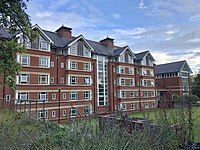
Sporting grounds and Brian Heap Building

Richard Laws Building
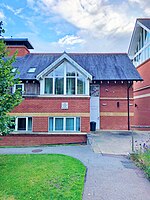
Geoffrey Cook Building

College orchards
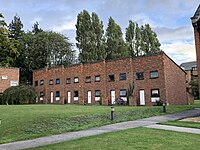
Maisonettes for families

Norfolk Extension

Bene't House

College Chapel
Academic profile[]
St Edmund's is one of the most international colleges of the university, with students from over 80 countries (2018-2019 academic year). The full spectrum of academic subjects is represented in the college. The fellowship of the college (academic staff) represents many academic disciplines, spread across arts, humanities, social sciences, natural sciences, medicine, and veterinary medicine.
The college has two research institutes: the Von Hügel Institute founded in 1987 to carry out research on Catholic Social Teaching; and the Faraday Institute which explores the relationship between religion and science. The Von Hügel Institute is another link with the Roman Catholic origins of the college.
The overall examination results of the college's comparatively few undergraduates tend to be in the middle among the Cambridge colleges, with St Edmund's ranking 21st on the Tompkins table in 2018.[17]

Student life[]
The college is younger than some of the older, more traditional colleges of the university. Despite this St Edmunds maintains many ancient Cambridge traditions including formal hall, albeit with some college modifications. Fellows at most Cambridge and Oxford colleges dine at a "high table" (separately from the students); however, St Edmund's has no such division, allowing undergraduates, postgraduates and Fellows to mix over dinner and other social activities. St Edmund's students are still strictly required to wear their academic gowns during formal halls, ceremonies, and college occasions. The St Edmund's gown is fashioned from distinctive black cloth with close detailing around the neck and sleeves. The robe may only be worn by members of St Edmund's College, Cambridge. The college has a long sporting tradition, including the St Edmund's College Boat Club. In recent years members have competed in varsity teams representing Cambridge University against Oxford University in a wide variety of sports, most notably, at The Boat Race and The Varsity Match.
On 15 September 2017, a team of four rowers from the college broke the World record for the 'Longest Continual Row' in the male 20-29 small team category by over an hour.[18] The following year, on 13 April 2018, a team of ten rowers from the college went on to set the British and World record for "One Million Meters" on the indoor rowing machine in the male 20-29 large team category.[19][20]
People associated with St Edmund's College, Cambridge[]

Catherine Arnold OBE, Master of St Edmund's College and former British Ambassador to Mongolia

Chito Gascon, Chair of the Human Rights Commission of the Philippines

Georges Lemaître, Belgian astronomer and cosmologist who formulated the modern Big Bang theory

Mary McAleese, former President of Ireland
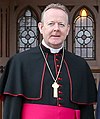
Eamon Martin KC*HS, Archbishop of Armagh and the Primate of All Ireland

Martin Evans, British biologist and recipient of the Nobel Prize in Physiology or Medicine
Alumni[]
- Edward Acton, Vice-Chancellor of the University of East Anglia, historian and great-grandson of Lord Acton
- Joaquín Almunia, Spanish politician and member of the European Commission responsible for Economic and Monetary Affairs
- Simon Amor, Current Head Coach of the England Sevens, member of the England Sevens at the 2002 Manchester Games
- Caroline Calloway, American Instagram personality
- William T. Cavanaugh, director of the Center for World Catholicism and Intercultural Theology, and professor of Catholic studies at DePaul University
- James Chau, Journalist
- Chito Gascon, Chair of the Human Rights Commission of the Philippines
- Alex Hughes, Archdeacon of Cambridge
- Hilary Lofting, Australian novelist, travel writer, journalist and editor. Eldest brother of Hugh Lofting (author of The Story of Doctor Dolittle).
- Louise Lombard, English actress[21]
- Eamon Martin, Archbishop of Armagh and the Primate of Ireland
- Rodrigo Rosenberg Marzano, Guatemalan attorney and human rights activist
- Alexander Masters, author, screenwriter, and worker with the homeless. Masters was portrayed by Benedict Cumberbatch in Stuart: A Life Backwards.
- Anna Mendelssohn, British writer, poet, and political activist
- Robert Noel, Officer of Arms (Herald) at the College of Arms
- Richard Phelps (rower), rower who competed in the 1992 Summer Olympics
- Norman St John-Stevas, Baron St John of Fawsley, legal scholar, former master of Emmanuel College, and Leader of the House of Commons under Margaret Thatcher was a resident at St Edmund's House for his undergraduate studies in late 1940s and early 1950s. During his time he was the president of the Union Society
- Thorsten Streppelhoff, Olympic Silver Medalist and German M8+ Rower at the 1996 Atlanta and 1992 Barcelona Games
- Marc Weber, Olympic Silver Medalist and German M8+ Rower at the 1996 Atlanta Games
- Stuart Welch, Olympic Silver Medalist and Australian M8+ Rower at the 2000 Sydney Games
Fellows[]
- Sir Martin Evans FRS FMedSci, Laureate of the 2007 Nobel Prize in Physiology or Medicine
- Sir Brian Heap CBE FRS is a biologist who was the master of the college from 1996 until 2004. He was elected a fellow of the Royal Society in 1989 and held the post vice-president and foreign secretary from 1996 to 2001.
- Georges Lemaître, cosmologist and Big Bang theorist, was a visiting academic at the college in 1923–24, while collaborating with Sir Arthur Eddington
- Helen Mason, theoretical physicist
- Simon Mitton, astronomer and author. Elected member of the Council of the Royal Astronomical Society.
Honorary Fellows[]
- Francis Campbell, former UK Ambassador to the Holy See
- Mary McAleese, former President of Ireland and patron of the college's Von Hugel Institute
- Prince Philip, Duke of Edinburgh, the Chancellor Emeritus of Cambridge University. He officially opened three new college buildings on 8 October 2007.
- Amartya Sen, laureate of the 1998 Nobel Prize in Economics
- Peter Smith, Metropolitan Archbishop of Southwark (London)
List of Masters of St Edmund's College[]
St Edmund's House
- 1897–1904: William Ormond Sutcliffe
- 1904–1909: Edmund Nolan
- 1909–1918: Thomas Leighton Williams
- 1918–1921: Joseph Louis Whitfield
- 1921–1929: John Francis McNulty
- 1929–1934: Cuthbert Leonard Waring
- 1934–1946: John Edward Petit
- 1946–1964: Raymond Corboy
- 1964–1976: Garrett Daniel Sweeney
- 1976–1985: John Coventry
- 1985–1996: Richard Laws
St Edmund's College
- 1996–2004: Brian Heap
- 2004–2014: Paul Luzio
- 2014–2019: Matthew Bullock
- 2019–present: Catherine Arnold
References[]
- ^ Shown here erroneously as French martlets gules
- ^ University of Cambridge (6 March 2019). "Notice by the Editor". Cambridge University Reporter. 149 (Special No 5): 1. Retrieved 20 March 2019.
- ^ "Accounts for the year ended 30 June 2019" (PDF). St Edmund's College, Cambridge. Retrieved 22 February 2020.
- ^ lr387@cam.ac.uk. "Baron Anatole von Hügel – Von Hügel Institute". www.vhi.st-edmunds.cam.ac.uk. Retrieved 31 March 2019.
- ^ "St Edmund's College - University of Cambridge". www.st-edmunds.cam.ac.uk. Retrieved 31 March 2019.
- ^ Jump up to: a b lr387@cam.ac.uk. "Baron Anatole von Hügel – Von Hügel Institute". www.vhi.st-edmunds.cam.ac.uk. Retrieved 2 April 2019.
- ^ E Leedham-Green 1996 A concise history of the University of Cambridge. Cambridge University Press: 171-2.
- ^ Leader, Damian R. (April 1998). "A concise history of the University of Cambridge. By Elisabeth Leedham-Green. Pp. xiv+274 incl. endpapers, 45 plates and 5 figs. Cambridge: Cambridge University Press, 1996. £27.95 (cloth), £9.95 (paper). 0 521 43370 3; 0 521 43978 7". The Journal of Ecclesiastical History. 49 (2): 329–380. doi:10.1017/s0022046997435832. ISSN 0022-0469.
- ^ "St Edmund's College - University of Cambridge". www.st-edmunds.cam.ac.uk. Retrieved 2 April 2019.
- ^ "Development". www.st-edmunds.cam.ac.uk. Retrieved 1 February 2020.
- ^ "St Edmund's College Cambridge - Royal Charter - 1998" (PDF). www.st-edmunds.cam.ac.uk. Retrieved 1 February 2020.
- ^ St Edmund's College, Cambridge
- ^ Jump up to: a b "St Edmund's College - Origins". www.st-edmunds.cam.ac.uk. Retrieved 29 September 2019.
- ^ Jump up to: a b "St Edmund's College - Modern Day". www.st-edmunds.cam.ac.uk. Retrieved 29 September 2019.
- ^ Jump up to: a b c "St Edmund's College - Chapel". www.st-edmunds.cam.ac.uk. Retrieved 29 September 2019.
- ^ Jump up to: a b lr387@cam.ac.uk. "History – Von Hügel Institute". www.vhi.st-edmunds.cam.ac.uk. Retrieved 29 September 2019.
- ^ "Tompkins Table 2013: The Results". Cambridge.tab.co.uk. Archived from the original on 4 June 2015. Retrieved 2 March 2015.
- ^ "St Edmund's College rowers break world record".
- ^ "St Edmund's College - University of Cambridge".
- ^ "World 100,000 Meters".
- ^ Article in St Edmunds College Website
Further reading[]
- Lubenow, W. C. (2008). "Roman Catholicism in the University of Cambridge: St Edmund's House in 1898". Journal of Ecclesiastical History. 59 (4): 697–713. doi:10.1017/S0022046907002254.
- McClelland, V. Alan (1997). "St. Edmund's College, Ware and St. Edmund's College, Cambridge; Historical Connections and Early Tribulations". British Catholic History. 23 (3): 470–83. doi:10.1017/S0034193200005811.
- Sweeney, Garret (1980). St Edmund's House, Cambridge: The First Eighty Years: A History. Cambridge: St Edmund's House. ISBN 978-0-95-071770-8.
- Walsh, Michael (1996). St Edmund's College, Cambridge, 1896–1996: A Commemorative History. Cambridge: St Edmund's College. ISBN 978-0-95-071771-5.
External links[]
| Wikimedia Commons has media related to St Edmund's College, Cambridge. |
- St Edmund's College, Cambridge
- Colleges of the University of Cambridge
- 1896 establishments in England
- Educational institutions established in 1896
- Grade II listed buildings in Cambridge
- Grade II listed educational buildings
- Catholic Church in Cambridge





















